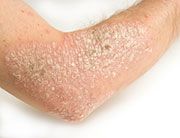Article
Psoriasis News and Updates
Author(s):
News from the literature on a possible link between atherosclerosis and psoriasis and quality of life for patients with this skin condition.

The October issue of the Journal of the American Academy of Dermatology (JAAD) featured several articles on psoriasis. Topics include quality of life for psoriasis patients and comorbidities associated with the skin condition.
Examining Differences Between Clear vs. Almost Clear Skin
One of the first articles on psoriasis in the October issue of JAAD examines the differences between quality of life scores in patients with almost clear vs. clear skin.
The differences between Dermatology Life Quality Index (DLQI) scores and use of prescription topical medications were compared, based on patient reports. The researchers, who are from a number of institutions in the United States, performed a multi-center, cross-sectional study of 97 patients with clear skin and 441 with almost clear skin. Patients were receiving systemic therapy or phototherapy for a primary indication of plaque psoriasis, according to the study results in JAAD.
After adjusted analyses, the researchers found patients with clear vs. almost clear skin “were more likely to report no impact of psoriasis on quality of life (relative risk 1.60; 95% confidence interval 1.37-1.86).” Patients with clear skin as compared to almost clear skin were also to report no use of topical prescription medications in the preceding week (relative risk 2.08; 95% confidence interval 1.73-2.49).
“Clinically important differences in quality of life and prescription topical medication use exist between patients with clear versus almost clear skin,” the researchers write in JAAD. “Collectively, our results indicate that achievement of clear skin may be an important clinical distinction among patients with moderate to severe psoriasis.”
To see the study abstract, and for a link to the full-text version, please click here.
Psoriasis May Be Independent Risk Factor for Subclinical Atherosclerosis
The body of research on psoriasis comorbidities is increasing. Conditions that arise in relation to psoriasis include cardiovascular disease, diabetes, obesity, and others. Another study in the October issue of JAAD examines the link between psoriasis and subclinical atherosclerosis.
Reza M. Robati, MD, and fellow researchers from Iran evaluated the possible association between subclinical atherosclerosis and psoriasis “by measuring the intima-media wall thickness (IMT) of the common carotid artery (CCA) in patients with psoriasis and evaluating its correlation with serum leptin and resistin levels,” according to the study results in JAAD. The team compiled data on mean intima-media wall thickness (MIMT) of the CCA and leptin, resistin, triglyceride (TG), and total cholesterol levels in serum.
Study results revealed that serum leptin, resistin, TG, and total cholesterol levels and MIMT of the CCA were significantly increased in psoriasis patients. Additionally, MIMT of the CCA was positively correlated with serum leptin, resistin, TG, and total cholesterol levels in patients with psoriasis.
According to the researchers, while serum leptin, resistin, TG, and total cholesterol levels and MIMT of the CCA were significantly increased in patients with psoriasis, MIMT of the CCA was also positively correlated with these biomarkers. As a result, according to the abstract in JAAD, psoriasis may be an independent risk factor for subclinical atherosclerosis.
To see the study abstract, and for a link to the full-text version, please click here.





